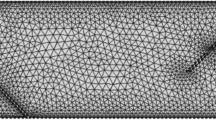Abstract
Laminar periodic flow and heat transfer in a three-dimensional channel with triangular wavy baffles (TWBs) have been numerically investigated. The baffles with three different angles of attack: 30°, 45° and 60° have been considered for Reynolds numbers ranging from 100 to 1000. For a better understanding in the heat transfer mechanisms, the pressure contour, secondary flow pattern, streamlines of impinging flow, wall streamline and iso-surface are also reported. Apparently, each wavy baffle generates two counter-rotating vortices. The 30° and 45° baffles generate vortices with comparable intensities which are considerably higher than that caused by 60° baffles. At similar conditions, the 30° and 45° baffles give comparable Nu/Nu0 values which are considerably higher than that provided by the 60° baffles, but the 30° baffles cause lower f/f 0 than the 45° and 60° baffles. For the range determined, the maximum thermal performances achieved by using baffles with the attack angles of 30°, 45° and 60° are 2.3, 2.2, and 1.88, respectively.
Similar content being viewed by others
References
A. M. E. Momin, J. S. Saini and S. C. Solanki, Heat transfer and friction in solar air heater mduct with V-shaped rib roughness on absorber plate, International Journal of Heat and Mass Transfer, 45 (2002) 3383–3396.
S. W. Ahn, H. K. Kang, S. T. Bae and D. H. Lee, Heat transfer and friction factor in a square channel with one, two, or four inclined ribbed walls, Transaction of ASME, Journal of Turbomachinery, 130 (2008) 034501.
K. R. Aharwal, B. K. Gandhi and J. S. Saini, Experimental investigation on heat-transfer enhancement due to a gap in an inclined continuous rib arrangement in a rectangular duct of solar air heater, Renewable Energy, 33 (2008) 585–596.
G. Tanda, Effect of rib spacing on heat transfer and friction in a rectangular channel with 45o angled rib turbulators on one/two walls, International Journal of Heat and Mass Transfer, 54 (2011) 1081–1090.
A. Lanjewar, J. L. Bhagoria and R. M. Sarviya, Experimental study of augmented heat transfer and friction in solar air heater with different orientations of W-Rib roughness, Experimental Thermal and Fluid Science, 36 (2011) 986–995.
P. Promvonge, C. Khanoknaiyakarn, S. Kwankaomeng and C. Thianpong, Thermal behavior in solar air heater channel fitted with combined rib and delta-winglet, International Communications in Heat and Mass Transfer, 38 (2011) 749–756.
P. Promvonge and C. Thianpong, Thermal performance assessment of turbulent channel flow over different shape ribs, International Communications in Heat and Mass Transfer, 35(10) (2008) 1327–1334.
Y. Liu, J. Cui, Y. X. Jiang and W. Z. Li, A numerical study on heat transfer performance of microchannels with different surface microstructures, Applied Thermal Engineering, 31 (2011) 921–931.
H. Liu and J. Wang, Numerical investigation on synthetical performances of fluid flow and heat transfer of semiattached rib-channels, International Journal of Heat and Mass Transfer, 54 (2011) 575–583.
Author information
Authors and Affiliations
Corresponding author
Additional information
Recommended by Associate Editor Man-Yeong Ha
Smith Eiamsa-ard is an Associate Professor of Mechanical Engineering at Mahanakorn University of Technology (MUT), Thailand. He obtained his D.Eng. in Mechanical Engineering from King Mongkut’s Institute of Technology Ladkrabang in 2006. He has been working at MUT since 1996. His research interests include Thermal&Fluid engineering, heat transfer enhancement and computational fluid dynamics. His efforts in research and engineering education have been recognized with the Association of Private Higher Education Institutions of Thailand, an award for the Outstanding Young researcher (2008) and an award for the Outstanding Scientist researcher (2012). Somchai Sripattanipat is an Assistant Professor of Mechanical Engineering at Mahanakorn University of Technology (MUT), Thailand. He received his D.Eng. (Mechanical Engineering) from King Mongkut’s Institute of Technology Ladkrabang (KMITL) in 2010. He has been working at the MUT since 2002. His research interests include enhanced heat transfer in channel, impinging jet and computational fluid dynamics.
Pongjet Promvonge obtained his Ph.D. (Mechanical Engineering) in 1997 from Imperial College of Science Medicine & Technology, University of London, U.K. He is currently an Associate Professor of Mechanical Engineering at King Mongkut’s Institute of Technology Ladkrabang (KMITL). Dr. Promvonge’s teaching and research interests include thermo-fuids, turbulence models, heat transfer, energy conservation and combustion.
Rights and permissions
About this article
Cite this article
Eiamsa-ard, S., Pattanapipat, S. & Promvonge, P. Influence of triangular wavy baffles on heat and fluid flow characteristics in a channel. J Mech Sci Technol 27, 2199–2208 (2013). https://doi.org/10.1007/s12206-013-0534-8
Received:
Revised:
Accepted:
Published:
Issue Date:
DOI: https://doi.org/10.1007/s12206-013-0534-8



